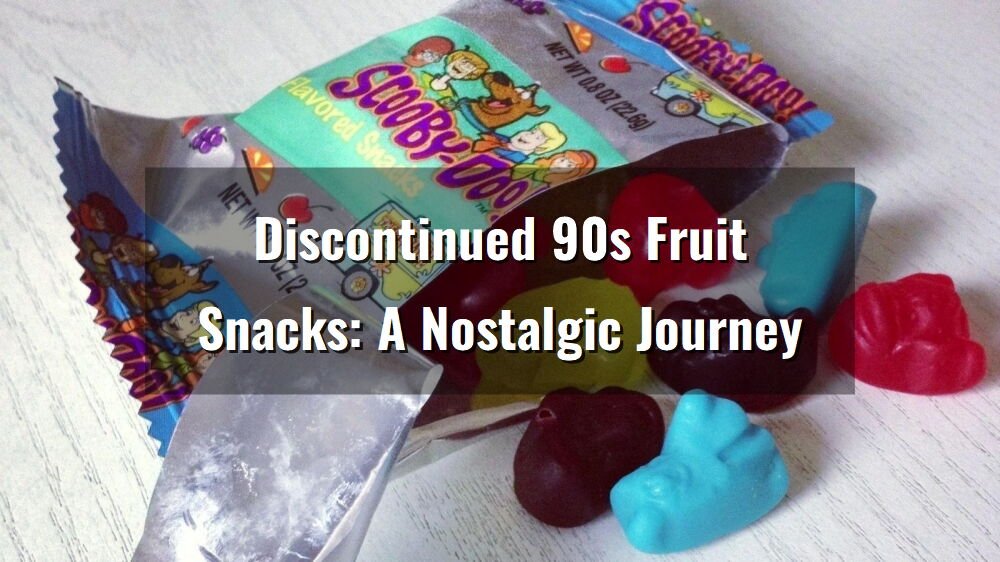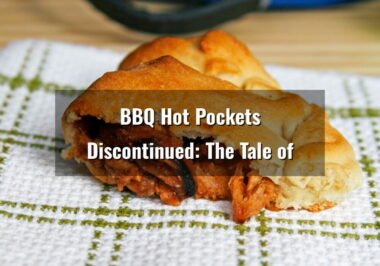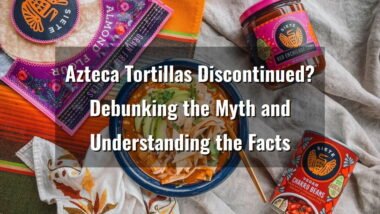Key Takeaways
- Many beloved fruit snacks from the 90s are no longer produced, leaving behind a legacy of fun, quirky flavors and memorable packaging.
- Health trends, intense competition, and shifting consumer preferences contributed to their disappearance.
- The unique, themed packaging—often tied to popular cartoons like Darkwing Duck and Garfield & Friends—made these snacks a cultural phenomenon.
- Some snacks, like Bonkers, have experienced brief revivals, underscoring the lasting nostalgia and demand for these treats.
- From edible fruit strings to candy with a “gross” twist, the 90s offered a diverse range of snacks that still capture the hearts of those who grew up with them.
Referenced Links
- Gone But Not Forgotten Groceries: Fruit Wrinkles
- Bonkers candy – Wikipedia
- 14 Discontinued Fruit Snacks We’d Love To Bring Back – Tasting Table
- 27 Discontinued Snack Foods From The ’90s You Totally Forgot About – The Daily Meal
- Bonkers! ® Fruit Chews are Back! – PR Newswire
Introduction: A Blast from the Past
In the 1990s, colorful packaging, robust flavors, and inventive designs ruled the snack market, making them magical for kids and adults. People like fruit snacks among these treats. Snacks were typically related to popular cartoons and unusual themes, making snack time an adventure.
As fashions changed and health concerns became more important, many of these nostalgic pleasures were discontinued. Today, discontinued 90s fruit snacks bring back warm recollections and bittersweet nostalgia of an era when even foods had personalities.
The Golden Era of 90s Fruit Snacks
The 90s snack aisle was a playground for inventiveness. Companies produced a variety of delectable and attractive fruit snacks. More than food, these snacks reflected the era’s lively pop culture. An ordinary snack became a collectible with bright colors, odd shapes, and themed packaging.
A Cultural Phenomenon
Pop culture references adorned kids’ lunchboxes and after-school snacks. Cartoons like Darkwing Duck and Garfield & Friends were not merely entertainment, but also brands that inspired product lines. A fruit snack with a popular mascot or a creative take on fruit flavors often became an overnight hit.
A Detailed Look at Discontinued 90s Fruit Snacks
The following table provides an overview of some of the most memorable discontinued fruit snacks from the 90s, outlining their history, unique features, and reasons behind their eventual discontinuation.
| Fruit Snack Name | Introduction Year | Discontinuation Year | Description | Additional Notes |
|---|---|---|---|---|
| Fruit String Thing | 1994 | 2005 | Edible, fruit-flavored strings that kids could twist and shape; competed with Fruit by the Foot. | Fondly remembered on social media; likely discontinued due to stiff competition. |
| Fruit Wrinkles | 1986 | Late 1990s (approx.) | Soft, jelly-bean-like snacks designed to make raisins appealing to kids. | Marketed as a healthier option; gradually faded as consumer tastes shifted. |
| Bonkers | 1980s | Late 1990s (brief revival in 2018) | Chewy fruit snacks with a fruity outer layer and a tart center, available in multiple flavors. | Experienced a short-lived comeback in 2018; current availability remains uncertain. |
| Boogers | Late 1980s | Late 1990s | Fruit-flavored candies with a quirky name and appearance; flavors like “Goopy Grape.” | Trademark expired in 1998; inspired similar products like “Box of Boogers.” |
| Sodalicious Gems | 1990s | 1998 | Soda-flavored fruit snacks molded into bottle shapes, offering a tingly taste. | Likely discontinued due to its niche appeal and limited market reach. |
| Berry Bears | 1980s | 1990s | Multicolored, cute snacks featuring pegasus-shaped pieces, primarily targeted at girls. | Remains a nostalgic favorite on social media despite no specific discontinuation reason. |
| Two-T-Fruits | Late 1980s | Around 1990 | Tube-like fruit snacks with a surprise center, often featured in quirky worm-like commercials. | Their offbeat marketing might have contributed to their early discontinuation. |
| Darkwing Duck Fruit Snacks | Early 1990s | Around 1996 (trademark canceled 2004) | Snacks themed after the popular Darkwing Duck cartoon, part of the Fruit Parade series. | Tied closely to the cartoon’s merchandising; lost popularity as the show’s influence waned. |
| Nickelodeon Crazy Colors Fruit Roll-Up Snacks | 1990s | 1996 | Character-shaped fruit roll-ups with vibrant, ombre colors and distinct flavors. | Likely a limited edition; distinct from modern Fruit Roll-Ups offerings. |
| Garfield & Friends Fruit Snacks | Early 1990s | Around 1993 | Character-shaped snacks featuring nostalgic textures and occasionally fun add-ons. | Their decline paralleled the waning popularity of the associated TV series. |
| Surf’s Up! Fruit Snacks | 1990 | 1991 | Ocean-themed fruit snacks that came with bonus items like wristbands. | Their short run makes them a rare and memorable part of 90s snack history. |
Factors Behind Their Discontinuation
The disappearance of these innovative snacks can be attributed to several converging factors:
Shifting Health Trends
The 90s marked the beginning of a more health-conscious era. Parents started to scrutinize the sugar content and artificial ingredients in their children’s snacks. As nutritional guidelines tightened and consumers became more aware of healthier alternatives, many fruit snacks—despite their fun packaging—could not keep up with the evolving demands of the market.
Fierce Competition and Market Saturation
The snack market in the 90s was bustling with creativity. While this fostered innovation, it also led to fierce competition among brands. Products that couldn’t carve out a unique niche or continuously adapt to changing consumer tastes eventually fell by the wayside. Many of the discontinued snacks struggled to maintain their market share against competitors like Fruit by the Foot, which remained popular for its simple yet appealing concept.
Tied to Pop Culture Fads
Many of these fruit snacks were closely tied to pop culture and specific cartoon franchises. As the popularity of these shows waned, so too did the appeal of the snacks associated with them. For example, the themed packaging of Darkwing Duck and Garfield & Friends fruit snacks was a major selling point during the height of their respective shows. However, as new shows emerged and trends shifted, these products lost the cultural momentum that once drove their success.
Limited Longevity of Novelty
The 90s were known for novelty in packaging and design. What was once considered a fun, temporary trend quickly became passé as consumer interests evolved. Even snacks that were initially lauded for their innovative concepts—like the worm-themed Two-T-Fruits or the soda-flavored Sodalicious Gems—eventually couldn’t sustain interest over the long term, leading to their discontinuation.
Nostalgia and Legacy
Even though these fruit snacks are no longer found on store shelves, they have left an indelible mark on pop culture. Social media platforms such as Reddit and X (formerly Twitter) are filled with reminiscences and fond memories of these products. Fans continue to celebrate their quirky designs, bold flavors, and the innovative marketing that defined an era.
The Role of Social Media
Online communities have played a significant role in keeping the memory of these snacks alive. Threads discussing everything from the chewy texture of Garfield & Friends fruit snacks to the fun of shaping Fruit String Thing have contributed to a collective nostalgia. This digital remembrance has even spurred discussions and petitions for the return of some of these long-gone treats.
Revival Attempts
Perhaps the most notable case of revival is that of Bonkers. Originally discontinued in the late 90s, Bonkers fruit chews experienced a brief resurrection in 2018, as reported by PR Newswire. Although their current availability remains uncertain, this attempt to reintroduce a beloved snack underscores the enduring impact and nostalgic value of these products. The revival highlights how brands can tap into the emotional connection that consumers have with their past, even decades later.
Unexpected Revival: The Case of Bonkers
Bonkers is a standout example of how nostalgia can sometimes prompt a return to the market. Despite its initial discontinuation driven by market dynamics and consumer shifts, the brand experienced a brief revival—demonstrating that even discontinued products can spark renewed interest. The revival, though short-lived, serves as a case study in how brands can leverage nostalgia to reconnect with former fans and even attract a new audience.
What Made Bonkers So Special?
- Unique Flavor Profile: With a combination of a fruity exterior and tart center, Bonkers offered a flavor experience that set it apart from other snacks.
- Memorable Packaging: The design of Bonkers was eye-catching and fun, often appealing directly to children’s sense of adventure.
- Cultural Impact: Its presence in the market during the vibrant 80s and 90s allowed it to become a memorable part of childhood for many, leading to a strong emotional connection even years after its discontinuation.
Challenges to Revival
Reviving a discontinued product is never straightforward. Factors such as changing consumer tastes, the competitive landscape, and evolving health standards can all pose challenges. While Bonkers did make a comeback in 2018, its current status remains a reminder of the complexities behind reintroducing nostalgic brands into a modern market.
Bringing It All Together
The story of discontinued 90s fruit snacks is more than just a tale of products that once filled lunchboxes—it’s a reflection of an era defined by innovation, cultural influence, and rapid change. These snacks were not only food items; they were a snapshot of the 90s zeitgeist, complete with bold flavors, creative designs, and an undeniable connection to pop culture.
The discontinuation of these products tells us much about the evolving priorities of consumers. While they were once at the forefront of snack innovation, shifting trends in health, market competition, and the transient nature of pop culture led to their gradual exit from the market. Yet, their legacy endures through nostalgic memories, online communities, and occasional revival attempts that remind us of a time when even our snacks were an adventure.
The vibrant history of these snacks is captured not only in tables and statistics but also in the personal stories of those who grew up with them. The laughter, the shared moments of joy, and the simple pleasure of unwrapping a uniquely shaped fruit snack continue to resonate with fans, even decades later.
FAQ
What made 90s fruit snacks different from today’s?
The 90s saw dramatic flavor and design experiments. Snacks had fun forms, bright colors, and cartoon and pop culture motifs. This made eating a fruit snack an adventure rather than just a snack. Healthy and stable flavor profiles dominate today’s snacks, lacking the 90s’ whimsical creativity.
Why were many snacks discontinued?
These famous snacks were discontinued for many reasons. Health trends drove consumers and parents to demand healthier options, while market competition forced corporations to streamline their product portfolios. Many snacks were also related to short-lived cultural trends like cartoons or fads, which fell out of favor.
Has anyone tried to bring back these snacks?
The 2018 Bonkers fruit chew resurrection was remarkable. This comeback shows that these classic foods are still nostalgic, even though their availability is questionable. The emotional connection many buyers have to these products drives re-release interest.
How does nostalgia affect the food market?
In the food sector, nostalgia is powerful. It can increase consumer interest and reintroduce discontinued products. Many brands rename or revive iconic delicacies to appeal to both nostalgic consumers and interested newcomers. Social media and online groups create a common space for nostalgia and celebration, amplifying this effect.
Could these discontinued treats return?
Always possible. Brands may revive classic products if there is enough sentimental appeal and enough market research. Any resurrection must blend nostalgia with modern health and customer expectations. A successful reintroduction requires market analysis and innovation while retaining the original product’s appeal.




